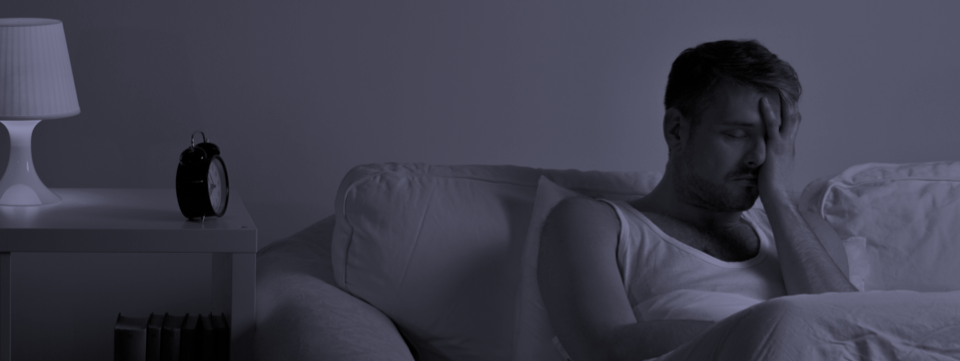
What is insomnia?
Insomnia is characterized by difficulty falling asleep, difficulty staying asleep, poor sleep quality, and/or inadequate sleep duration despite adequate opportunity for sleep.
Various studies worldwide have shown the prevalence of insomnia in 10%–60% of the population (Taylor et al.,2007; Buysse et al., 2008; Schutte-Rodin et al., 2008).
Insomnia is common in older adults, females, and people with medical and mental health issues.
Insomnia has been categorized as:
Short-term/Acute insomnia – short-term and lasts for a few days up to a month
Chronic insomnia – difficulty falling asleep or staying asleep at least three nights per week, for at least three months
Sleep onset insomnia – difficulty falling sleep
Sleep maintenance insomnia – inability to stay asleep through the night
Early morning awakening insomnia – waking up well before wanting to
Mixed insomnia – a combination of insomnia types
Consequences of insomnia can include:
- impaired next-day physical and mental function
- poorer quality of life
- impaired work performance
- increased work- and motor-vehicle-related accidents
Getting less than six hours of sleep has been associated with (Barnett, 2008):
- increased depression, anxiety, and stress symptoms
- poorer overall well-being
- making more errors on simple mental tasks
- increased heart rate
Insomnia and immunity
Sleep deprivation has been shown to cause a significant shift towards Th2 immune dominance. Th2 dominance is a strong risk factor for developing allergies and autoimmune diseases (Sakami et al., 2002).
Insomnia and obesity
Sleep deprivation in young adults was shown to promote changes that are associated with weight gain, including (Van Cauter & Knutson, 2008):
- decreased glucose tolerance
- decreased insulin sensitivity
- increased evening cortisol levels
- increased levels of the hunger-promoting hormone ghrelin
- decreased levels of the appetite regulating hormone leptin
- increased hunger and appetite
Medical standard of care
Conventional management of insomnia can include:
- sleeping pills and sedative-hypnotics
- medications that bind melatonin receptors
- allergy or cold medication
- Cognitive-Behavioural Therapy for Insomnia (CBT-I)
- assistive breathing device or surgery (usually for sleep apnea)
Key factors that affect sleep
The main factors that affect sleep are:
- circadian rhythms
- sleep pressure
- sleep disruptors
Circadian rhythms
- Circadian rhythms are cycles that are part of the body’s internal clock system. They synchronize with cues from the environment like light and temperature to direct processes in the body – including sleep. Important regulators of circadian rhythms in the context of sleep are light exposure and melatonin.
- In response to darkness, the pineal gland in the brain produces melatonin, which aids in the regulation and enhancement of various circadian rhythms throughout the body (Atul Khullar, 2012).
Sleep pressure
Sleep pressure is a drive to sleep that builds up as time awake increases, and decreases with time asleep.
- Sleep pressure is mediated by the molecule adenosine, which gradually increases in the brain throughout the day, and binds to cells in regions of the brain that decrease alertness, and increase sleepiness. (What Is Sleep Pressure and How to Get Enough of It, 2022).
- Sleep pressure can also be increased under conditions of illness, and with mentally or physically demanding activity.
- Sleep pressure can be decreased with stimulants like caffeine, daytime napping, and a state of metabolic hyperarousal.
Hyperarousal is described a state of increased body, brain, and cognitive activation (Chapman et al., 2018).
- Indicators of hyperarousal were found to be significantly increased in insomniacs 30 minutes before and during sleep (Bonnet, n.d.)
The neurotransmitters dopamine and serotonin also affect sleep pressure by their actions in the pineal gland.(What’s the Difference Between Dopamine and Serotonin?, 2020).
- Dopamine decreases sleep pressure by inhibiting norepinephrine, which promotes wakefulness.
- Serotonin has roles in both promoting wakefulness, and as the precursor for melatonin – which promotes sleep .
Sleep disruptors
Sleep disruptors are conditions that are not directly tied to circadian rhythms or sleep pressure, but decrease ability to sleep, or achieve quality sleep. Some sleep disruptors include stress, restless leg syndrome, muscle or nerve pain, and sleep apnea.
Definition of sleep terms
Sleep efficiency is the percentage of time asleep while in bed
Sleep latency is the amount of time it takes to fall asleep after turning out the lights
Sleep quality is a measure of one’s satisfaction with sleep, incorporating sleep initiation, latency, quantity, and feeling refreshed on awakening
Why consider an orthomolecular approach?
Insomnia has numerous biological causes and contributors that have been identified through nutritional research and clinical practice. Each individual may experience insomnia for different reasons.
An orthomolecular approach:
• identifies the drivers and causes of insomnia and focuses on understanding them
• works WITH the body to restore balance and normal function, and considers the person with the condition versus just the condition
• addresses nutrient depletions that promote insomnia whereas medications do not
• can be done SAFELY in conjunction with most medical interventions


